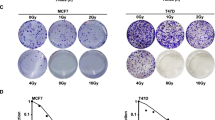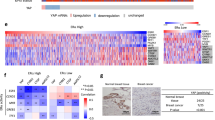Abstract
T47D cells represent an estrogen-responsive human ductal carcinoma cell line which expresses detectable levels of estrogen receptor (ER). We have previously shown that estradiol (E2) treatment of T47D cells causes an increase in the level of p53 and a concomitant phosphorylation of retinoblastoma protein (pRb). In the present study, we have analysed the expression of p53 and phosphorylation state of pRb and compared the effects of E2 and triiodothyronine (T3) on these phenomena. Cells were grown in a medium containing charcoal-treated serum to deplete the levels of endogenous steroids. Upon confluency, the cells were treated with T3 (10−12 to 10−7 M) for 24 h and the presence of p53 and pRb was detected by Western analysis. E2 treatment of cells caused a 2–3-fold increase in the level of p53. Presence of T3 in the medium caused a gradual increase in the level of p53 in a concentration-dependent manner. Under the above conditions, pRb was phosphorylated (detected as an upshift during SDS–PAGE) in the presence of E2 and T3. Supplementation of growth medium with T3 (1 μM) caused an increase in the rate of proliferation of T47D cells and induced hyperphosphorylation of pRb within 4 h; this effect was maintained for up to 12 h. When ICI 164 384 (ICI) (1 μM), an ER antagonist, was combined with E2 (1 nM) or T3 (1 μM), effects of hormones on cell proliferation and hyperphosphorylation of pRb were blocked. Western analysis of p53 was supplemented with its cytolocalization by immuno-labeling using laser scanning confocal fluorescence microscopy, which revealed an ICI-sensitive increase in the abundance of p53 in hormone-treated cells. Steroid binding analysis revealed lack of competition by T3 for the [3H]E2 binding. These results indicate that T3 regulates T47D cell cycle progression and proliferation raising the p53 level and causing hyperphosphorylation of pRb by a common mechanism involving ER and T3 receptor (T3R)-mediated pathways.
This is a preview of subscription content, access via your institution
Access options
Subscribe to this journal
Receive 50 print issues and online access
$259.00 per year
only $5.18 per issue
Buy this article
- Purchase on Springer Link
- Instant access to full article PDF
Prices may be subject to local taxes which are calculated during checkout







Similar content being viewed by others
Abbreviations
- ATCC:
-
American type culture collection
- E2:
-
17-β estradiol
- ECL:
-
enhanced chemiluminescence
- ERE:
-
estrogen response element
- FBS:
-
fetal bovine serum
- ER:
-
estrogen receptor
- HBSS:
-
Hanks' balanced salt solution
- HSS:
-
high speed supernatant
- ICI:
-
ICI 164 384
- OHT:
-
4-hydroxy tamoxifen
- p53:
-
53-kDa tumor suppressor protein
- PBS:
-
phosphate-buffered saline
- PMSF:
-
phenylmethylsulfonyl fluoride
- PVDF:
-
polyvinylidene fluoride
- PR:
-
progesterone receptor
- pRb:
-
retinoblastoma protein
- ppRb:
-
phosphorylated pRb
- Rb:
-
retinoblastoma
- SDS–PAGE:
-
sodium dodecyl sulfate polyacrylamide gel electrophoresis
- SSFBS:
-
single stripped fetal bovine serum
- T3:
-
triiodothyronine
- TAM:
-
tamoxifen
- T3R:
-
thyroid hormone receptor
- TRE:
-
thyroid hormone response element.
References
Alvarado-Pisani AR, Suaraz C, Raul BJ, Lopez-Herrera L . 1986 Anticancer Res. 6: 1347–1352
Barrera-Hernandez G, Park KS, Dace A, Zhan Q, Cheng S-Y . 1999 Endocrinology 140: 5267–5274
Bhat MK, Yu C-L, Yap N, Zhan Q, Hayashi Y, Seth P, Cheng S-Y . 1997 J. Biol. Chem. 272: 28989–28993
Blohmer JU, Paepke S, Kissner L, Elling D, Fleige B, Grineisen Y, Lichtenegger W . 1999 Zentralbl. Gynekol. 121: 522–525
Burke RE, McGuire WL . 1978 Cancer Res. 38: 3769–3773
Cerbon M-A, Pichon M-F, Milgrom E . 1981 Cancer Res. 41: 4167–4173
Clarke CL, Sutherland RL . 1990 Endocrine Rev. 11: 266–301
Dellovade TL, Chan J, Vennstrom B, Forrest D, Pfaff DW . 2000 Nat. Neurosci. 3: 472–475
Dellovade TL, Kia HK, Zhu YS, Pfaff DW . 1999 Neuroendocrinology 70: 168–174
Dellovade TL, Zhu YS, Pfaff DW . 1995 J. Steroid Biochem. Molec. Biol. 53: 27–31
Dinda S, Sanchez A, Odigie I, Jalil Y, Hurd C, Moudgil VK . 1998 Proc. 80th Annual Meet Endocrine Soc., New Orleans, LA, June 24–27, abstract P-1 8
Dulic V, Kaufmann WK, Wilson SJ, Tisty TD, Lees E, Harper JW, Elledge SJ, Reed SI . 1994 Cell 76: 1013–1023
El-Deiry WS, Tokino T, Velculescu VE, Levy R, Parsons JM, Trent, Lin D, Mercer WE, Kinzler KW, Vogelstein B . 1993 Cell 75: 817–825
Franklyn JA, Sheppard MC . 1988 Clin. Endocrinol. 29: 337–348
Graupner G, Zhang X-K, Tzukerman M, Wills K, Hermann T, Pfahl M . 1991 Mol. Endocrinol. 5: 365–372
Horwitz KB . 1985 Endocrinology 116: 2236–2245
Horwitz KB . 1992 Endocrine Rev. 13: 146–163
Hurd C, Dinda S, Khattree N, Moudgil VK . 1999 Oncogene 18: 1067–1072
Hurd C, Khattree N, Alban P, Nag K, Jhanwar SC, Dinda S, Moudgil VK . 1995 J. Biol. Chem. 270: 28507–28510
Hurd C, Khattree N, Dinda S, Alban P, Moudgil VK . 1997 Oncogene 15: 991–995
Iwasaki K, Underwood B, Herman M, Dinda S, Kodali S, Kloosterboer HJ, Hurd C, Moudgil VK . 1999 Mol. Cell. Biochem. 198: 141–148
Kato S, Endoh H, Masuhiro Y, Kitamoto T, Uchiyama S, Sasaki H, Musushige S, Gotoh Y, Nishida E, Kawashima H . 1995 Science 270: 1491–1494
Kodali S, Burkley M, Nag K, Taylor RC, Moudgil VK . 1994 Biochem. Biophys. Res. Commun. 202: 1413–1419
Lin HY, Shih A, Davis FB, Davis PJ . 1999 Biochem. J. 338: 427–432
Morgan MA, Dellovade TL, Pfaff DW . 2000 Horm. Behav. 37: 15–22
Nigro JM, Baker SJ, Presenger AC, Jessup JM, Hostetter R, Cleary K, Bigner SH, Davidson N, Baylin S, Devilee P, Glover T, Collins FS, Weston A, Modali R, Harris CC, Vogelstein B . 1989 Nature 342: 705–708
Nogueria CR, Brentani MM . 1996 J. Steroid Biochem. Molec. Biol. 59: 271–279
Oren M . 1992 FASEB J. 6: 3169–3176
Parhar IS, Soga T, Sakuma Y . 2000 Endocrinology 141: 1618–1626
Qi JS, Desai-Yajnik V, Yuan Y, Samuels HH . 1997 Mol. Cell. Biol. 17: 7195–7207
Reisman D, Greenberg M, Rotter V . 1988 Proc. Natl. Acad. Sci. USA 85: 5146–5150
Shao ZM, Sheikh MS, Rishi AK, Dawson MI, Li XS, Wilber JF, Feng P, Fontana JA . 1995 Exp. Cell. Res. 218: 1–8
Shih A, Lin HY, Daid FB, Davis PJ . 2001 Biochemistry 40: 2870–2878
Wafik S, El-Deiry J, Harper W, O'Connor PM, Velculescu VE, Canman J, Jackman JA, Pietenpol JA, Burrell M, Hill DE, Wang Y, Wilman KG, Mercer WE, Kastan MB, Kohn KW, Elledge SJ, Kinzler KW, Vogelstein B . 1994 Cancer Res. 54: 1169–1174
Weinberg RA . 1995 Cell 81: 323–330
White E . 1994 Nature 371: 21–22
Xiong Y, Hannon GJ, Zhang H, Casso D, Kobayashi R, Beach D . 1993 Nature 366: 701–704
Yap N, Yu CL, Cheng SY . 1996 Proc. Natl. Acad. Sci. USA 93: 4273–4277
Acknowledgements
The studies were supported in part by National Institutes of Health, and the Research Excellence Fund, Center for Biomedical Research, Oakland University.
Author information
Authors and Affiliations
Corresponding author
Rights and permissions
About this article
Cite this article
Dinda, S., Sanchez, A. & Moudgil, V. Estrogen-like effects of thyroid hormone on the regulation of tumor suppressor proteins, p53 and retinoblastoma, in breast cancer cells. Oncogene 21, 761–768 (2002). https://doi.org/10.1038/sj.onc.1205136
Received:
Revised:
Accepted:
Published:
Issue Date:
DOI: https://doi.org/10.1038/sj.onc.1205136
Keywords
This article is cited by
-
Low thyroid hormone receptor alpha-2 (THRα-2) tumor expression is associated with unfavorable tumor characteristics and high breast cancer mortality
Breast Cancer Research (2021)
-
Hyperthyroidism is associated with breast cancer risk and mammographic and genetic risk predictors
BMC Medicine (2020)
-
Decreased expression of the thyroid hormone-inactivating enzyme type 3 deiodinase is associated with lower survival rates in breast cancer
Scientific Reports (2020)
-
Association between thyroid gland diseases and breast cancer: a case–control study
Breast Cancer Research and Treatment (2020)
-
Triiodothyronine Promotes Cell Proliferation of Breast Cancer via Modulating miR-204/Amphiregulin
Pathology & Oncology Research (2019)



